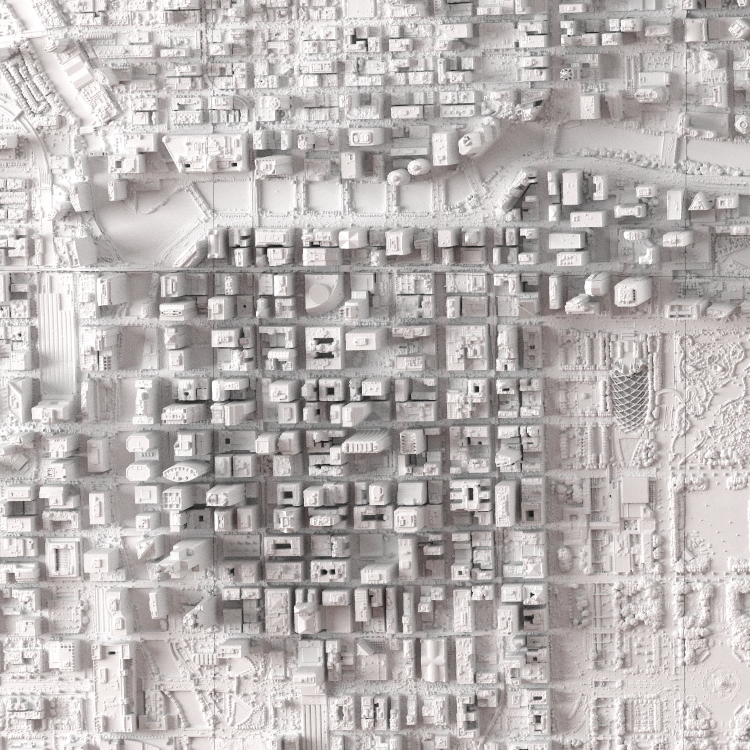One of our most popular offerings is custom artwork. And since most clients inquiring about a unique and often complex art piece haven’t seen a MiniCity model in real life, it’s essential that we clearly communicate the process that will ultimately bring the client’s vision to life and accurately present what the finished product will look like. We achieve this via computer renderings.
The origin of the word “render” is Latin and old French, meaning “give back” or “translate.” In the context of computer graphics, to “render” means to “convert a virtual three-dimensional model into a two-dimensional representation” — i.e., to make an image of it, as if with a virtual camera.
An integral part of our production process is generating virtual three-dimensional models of cities. These “meshes” are composed of tiny triangles — the building blocks of 3D computer graphics. Once generated, we can “slice” them into layers for 3D printing or prepare them for rendering into a 2D image by applying spatial transformations and adding material properties.
Triangle mesh of Cloud Gate in Millennium Park, Chicago
In June, a potential client approached us with a request to create a 3D map of Chicago that would be larger than any other work we’d printed — a massive 5-foot-tall piece. Given the scope of the project, we wanted to reassure the client that the final product would match their vision and meet all their expectations.
To do this, we created a rendering using our virtual test room: a minimalist living room with an 8-foot ceiling, medium-grey painted walls, and two windows (the largest is in a wall to the left). Remarkably, when we showed up to install the piece, we noticed that the physical wall was nearly the same color as our virtual test room, and the light emanated from the same direction! We photographed the real model from the same angle as we did in the virtual rendering. Here are both images:
Radiance rendering of Chicago model
Photograph of actual model as installed
The differences between these two images (primarily attributable to an inevitably imperfect match of our test room with the actual room) notwithstanding, the final result is very close to what we, and more importantly the client, expected.
In order to make these renderings as realistic as possible, we leverage years of research in multiple scientific fields: lighting design, computer science, physics and optics, computational geometry, and computational physics. Radiance, an open-source software toolkit, combines this knowledge into a powerful tool for accurately simulating the transport of light through arbitrary scenes. It allows us to set up a virtual scene: to place walls, lights, furniture and our virtual artwork, and generate an accurate image of a potential installation.
When we talk about the “transport of light” we are referring to the phenomenon of light bouncing off anything in a room until it is finally absorbed. Darker objects absorb more light and allow very little to bounce, while brighter-appearing surfaces enable more of the incoming light to bounce. Light will bounce in one direction from shiny objects (called “specular” reflection), and it will bounce off of matte or flat-finished surfaces (called “Lambertian”) in all directions.
Imagine an interior space with light colored walls and ceiling surfaces; any incoming light (from an electric fixture, window, or skylight) will bounce around many times, filling the space with illumination. This is one of the main reasons why art galleries have white walls and architectural models are built with white paperboard.
Radiance can accurately compute the transport (bouncing) of light through arbitrary scenes. To illustrate this effect, below are several renderings of the same scene (the model above, focusing on the famed “Chicago Loop”) allowing light to make 0, 1, and 3 bounces. Not only is the scene getting brighter with each ambient bounce (as walls and floors become new “light sources”) but light penetrates deeper into the urban canyons created by the city’s numerous skyscrapers.
No ambient bounces
One bounce
Three bounces
Radiance is just one of the tools we use to create impeccably-detailed 3D-printed cities and landscapes. When you buy a 3D city from us, you’re buying artwork refined by decades of knowledge and experience, not only in physics and computation, but detail-centric design and model-building. We deliver the best, because that’s the only art we’d hang on our own walls.
Have a vision for a custom work? Let us know and we’ll work with you to make your vision a reality.







